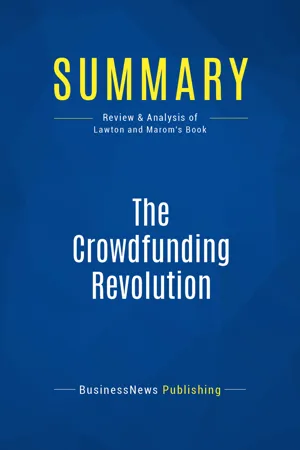
Summary: The Crowdfunding Revolution
Review and Analysis of Lawton and Marom's Book
- English
- ePUB (mobile friendly)
- Available on iOS & Android
Summary: The Crowdfunding Revolution
Review and Analysis of Lawton and Marom's Book
About this book
The must-read summary of Kevin Lawton and Dan Marom's book: `The Crowdfunding Revolution: Social Networking Meets Venture Financing`.
This complete summary of the ideas from Kevin Lawton and Dan Marom's book `The Crowdfunding Revolution` shows that crowdfunding is an innovative, collaborative way to fund projects: it is the fusion of social networking and venture capitalism to obtain funding for worthy causes, get capital for companies in exchange for an equity stake or to pre-sell items to fund production costs. In their book, the authors suggest that crowdfunding has the potential to be even more successful than traditional methods. This summary explains how you can take advantage of collective IQ and wallets, and how to implement this new type of investment model.
Added-value of this summary:
• Save time
• Understand key concepts
• Expand your knowledge
To learn more, read `The Crowdfunding Revolution` and discover the new, exciting route to funding.
Frequently asked questions
- Essential is ideal for learners and professionals who enjoy exploring a wide range of subjects. Access the Essential Library with 800,000+ trusted titles and best-sellers across business, personal growth, and the humanities. Includes unlimited reading time and Standard Read Aloud voice.
- Complete: Perfect for advanced learners and researchers needing full, unrestricted access. Unlock 1.4M+ books across hundreds of subjects, including academic and specialized titles. The Complete Plan also includes advanced features like Premium Read Aloud and Research Assistant.
Please note we cannot support devices running on iOS 13 and Android 7 or earlier. Learn more about using the app.
Information
Summary of The Crowdfunding Revolution (Kevin Lawton and Dan Marom)
The Road Here
- The rise of the crowd
- The decline of conventional financing
- The rise of outsiders with good timing
- The emergence of early stage funding
1. The rise of the crowd
- Affinity groups of like-minded individuals are everywhere. They are writing encyclopedias (Wikipedia), collaborating on difficult challenges and doing all kinds of other things.
- Almost everyone who uses the Internet today has become what’s termed a “pro-sumer” – someone who both consumes and produces information.
- An impressively large number of Internet users are also becoming “pro-ams” – amateurs who work to professional standards. Every time you review a restaurant you recently dined at, make some comments about a book you purchased online, share photos or re-mix YouTube videos, you’re doing things which would have been impossible to achieve just a few years ago. Social technologies delivered by the Internet have lowered the opportunity cost for people with talent and knowledge to exp...
Table of contents
- Title page
- Book Presentation
- Summary of The Crowdfunding Revolution (Kevin Lawton and Dan Marom)
- About the Summary Publisher
- Copyright